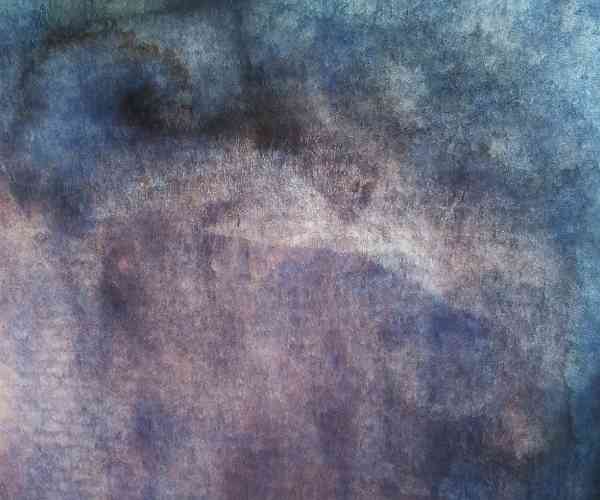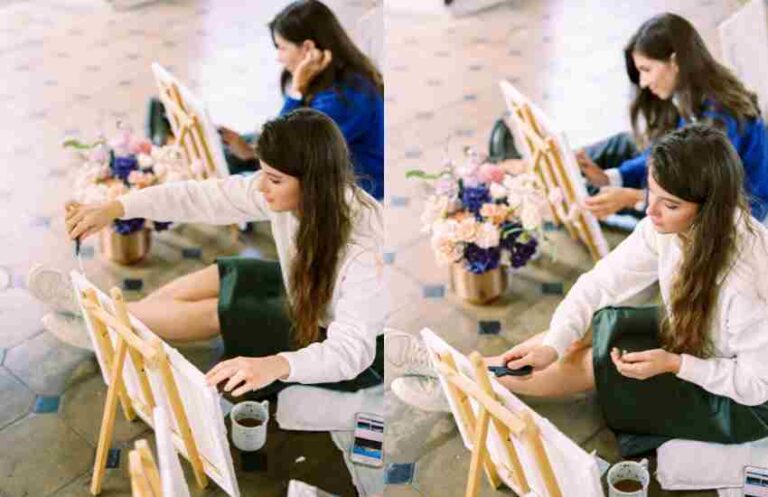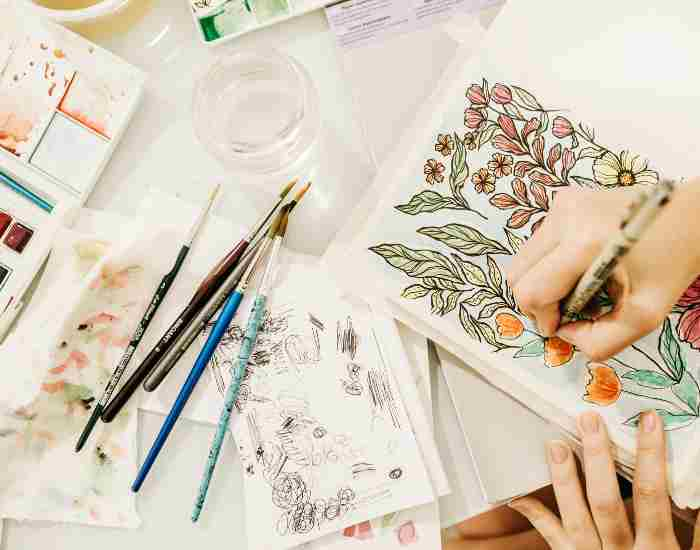Certain art styles are truly remarkable and one of them is undoubtedly watercolor. The combination of hues merging to form stunning sceneries or intricate flower designs is nothing less than a conversation between the artist and the canvas itself So unique, isn’t it?
The way colors and water interact is most certainly science, so mastering watercolor blending will surely help anyone looking to better their art skills. Furthermore, it isn’t solely reliant on the quality of brushes and papers, for having an understanding of how this medium operates will increase the quality exponentially.
My previous experience with watercolor blending feels almost omniscient looking back. I was preparing for a first attempt painting session in my art studio, with the intention of working with a few colors, it was raining heavily outside. The brush went into the water pot, followed by the blue pigment, however, it was the soft spread on the paper that piqued my interest. That day, I thoroughly explored the wet-on-wet blending technique and the amalgamation of twilight blue and gentle sky green inspired me. The entire process of watercolor blending did feel like storytelling, where I was a mere medium. That was the first time that I connected with the idea of painting, and since that day I have been interested in learning the art form in detail.

The Basics of Watercolor
Any artist worth their salt knows the importance of understanding the composition of paint, and watercolors are no exception. I consider this to be painting’s greatest invention, and I will explain why once the composition is fully understood. Watercolors comprise of three principal components: Color Pigments, Binders, and Additives
Natural, mineral, plant, and synthetic pigments are coloring agents that are responsible for the beautiful aura a water color possesses. And water color paint would need these since they don’t have color on their own.
Solely designed for blending, binders allow different chemicals, like pigments, to stick to specific surfaces. Watercolor paint is usually glue that helps keep binders, a natural resin, close. Such materials are important because they contribute greatly to the final composition.
Also surfactants, some preservatives and even some agents that help with the opacity/flow of the paint. Simply knowing these components will help significantly when making a decision on specific paints and what effects you desire from them.
Now, let’s consider the opposing characteristics of transparent and opaque watercolor paints. Light that penetrates through the surface, to the white paper that is behind, gets reflected by the paper. This is great for softer washes and mingled colors because it gives color an amazing reflectiveness. While painting skies transparent colors are an exceptional option due to the light’s subtle variation, I often find them to be exceptional since they transparently replicate such changes perfectly.
On the other hand, opaque watercolours have more pigment and less binding agent, which owing to their thicker consistency, being ideal for layering and solid coverage. A perfect example is employing opaque yellow paints for creating a highlight over a dark blue background forcing the striking contrast between the blue and the yellow. Blending techniques, as well as general impact of artwork done by you, can be greatly influenced by the type of paint chosen by you.
Water as a Medium
Water is not only the aid in watercolor painting; it is an integral aspect of the approach. It influences the movement of the paint, explains the mixing of the paint with other colors, and finally the way it is laid onto a page. Whenever you pour water onto your paints, you are not only diluting it but rather modifying its characteristics.
The quantity of water that you utilize can drastically influence the outcome of your blending. More water will typically result in softer edges with less distinct transitions whereas less water would mean a more pronounced colour with sharper edges and lines. For instance, if this was a landscape and you wished to achieve a misty effect you would be better off with a wet brush and lot of water enabling the colors to seamlessly merge.
Though, utilizing too much water should be avoided, and wielding control over the amount of water used is rather important. The paint may run in undesirable directions, leading to excessive blooms or even back runs. With this in mind, a good rule of thumb is to start with less water and gradually add more until you achieve the desired consistency.
When I started painting, I normally had difficulties maintaining the water in the right amounts, which resulted in rough water where I wanted to have gradients instead. But eventually, I was able to make lovely and gorgeous designs by using different amounts of water. So, there’s no reason to be concerned about how much paint or water you’re using — experiment and see what ratio works best for you.
Resolving issues when Blending Watercolors
As we explore deeper into the art of blending watercolors, overworking the paint is up there on being one of the most common problems many artists face. I recall the first time I attempted a wash and had to constantly go back to it and rework it.
Initially, it felt good. I was picturing the colors moving and merging into each other in a pleasing manner. However, I stepped back to take a proper look, and this was the critical moment, instead of a gradual transition, I had made a muddled mess with rough edges. Maintaining the paint, however, can result in an altered vitality and miss the appealing, fresh, and lively look that practically all watercolors appear to have.
So, what is the way out of it? The best advice that I could give is start accepting the idea of ‘letting go’. Whenever you colour the works, allow the color to breath applied to them and give it some time to settle. A general guide is to make some bold sweeps and then stand back. Give the paint some time to ready before deciding if it needs another coat or to be blended a little bit more.
Whenever you get the urge to go back and change something, instead ask yourself “What am I doing to the painting, am I improving the artwork or am I just wasting my time working on it.” This shift in thinking is very useful. It is all about knowing when to silence oneself; in watercolor painting, often less is better.
Uneven Blends
In my case, uneven blends can be a sore point because I have gone through it before! You can feel like a wizard painting with watercolors at times while feeling like a portion of your artwork does not seem to integrate at all.
The common blending mistakes can be inconsistent water application, inappropriate choice of brush and even the paper texture. For example, a brush that is a bit too stiff can create bold lines instead of soft ones. I recall using
different brushes, and it was during that time when I found out that a round brush can always be a versatile tool because it gives so much better blending.
Here are some solutions that would help you with achieving a more polished finish:
Rinse: Monitor the ratio of water to paint that you are using in every stitch of the painting. Once you see one area feels much wetter or drier than another, there is likely to be more a chance of roughness.
Sensitive Hand: Putting on paint with too much pressure will not be necessary, light applying will work just as fine if not better for the painting. A hand too heavy will likely ruin the work that is there; the approach to the brush should be aimed to float it across the paper rather than pull it across.
Watercolor Paper:Ensuring a high quality piece of watercolor would be really beneficial to the painting. It allows for better absorption and smoother blending.
Practice critiquing: Don’t be afraid to fail although i would like to first warn you that i recommend small swatch tests to sand , blend and add textures to your main Leica piece this way you get to practice three practices all at once.
Inspiration Put to Use:
Water color artist inspiring
To improve in self portrait watercolor it’s wise to learn from other artists . There is a multitude of artists that you can learn from. For instance the land scpaes of Joseph Zbukvic are quite eye pleasing as his soft hues immerses the viewer into the clouds, along with his other astounding pieces of creation.
Kathy O’Leary is another artists worth looking into , her flowers show how layering colors impacts the final piece and how moving adds a tropical and floral ‘petal’ touch. You can see her work at this link.
Social media can also be a great way to learn and interact with inspiring artists who will alter your perception regarding certain techniques and provoke you to try new ones when superimposed or viewed on their websites. Tutorials or live demonstrations of their methods are very beneficial.
Applying Science to Your Art
Learning the science of watercolor blending has certainly improved my paintings. At first, I thought blending is only driven by feeling and imagination, but after I understood the concept of blending, it was all different.
I recommend you to test out the blending methods we researched together. Try wet-on-wet and wet-on-dry blending on different types of raw papers. Use different ratios of water to paint and see what happens to your blends.
As for me, blending was a practice that helped me discover my medium. I would write down the blending methods that were successful as well as unsuccessful, creating a type of “blending journal”. This assisted me not only in enhancing my technique but also in establishing a closer relationship with my work.
So, pick up your brushes, put science to the work, and let your imagination out! Watercolor is the practice of curiosity and investigation, and the process is just as appealing as the result.
FAQs
Which paper is appropriate for watercolor blending?
For watercolor blending, the paper that you select can be vital in achieving good results. I would recommend using 100% cotton watercolor paper for the best possible blend, as this paper is highly absorbent and strong allowing the paint to blend softly.
I remember my first encounter with professional-grade cotton paper. It was a huge jump from the student-grade paper and it totally transformed my experience. The paint blended well allowing me to create the delicate blends I had always struggled with in the past. To avoid buckling when attempting to apply multiple layers of water, use paper that weighs no less than 200 lb (425 gsm).
The surface of the paper matters, too. Cold-pressed paper CP, or rough papers have a texture that ads up details in the shapes blending warm textures into the paintings. In contrast, hot-pressed paper, or smooth papers has a perfectly flat, smooth surface. They give a finer detail on the painting without losing coarse blending.
What do I do if the watercolor blend does not come out as expected; how do I redeem that blend?
I am sure all of us have been in such a situation where we spend hours on a blend only to look at it and feel disappointed. But there is no reason to feel sad, for there are ways to redeem that blend.
Allowing the painting to dry fully is one of the ways to approach your art in painting. In certain cases, During the drying process the paint seems to settle differently and forms a different unexpected beauty. If you feel after the painting is dry that it needs more help, dab a clean damp brush onto the paint and lift off a small portion of the paint. This technique involves gently dabbing the area of concern with a towel or cloth after dabbing it with water to make the darker regions appear lighter.
Another method is to use a different color to create a layer over the existing blend. As an instance, if you have an area that is muddy in a bad sense, a transparent colour glazing can be placed on it to have a different effect on it. A soft pink layer transformed a mediocre sunset blend into a luminous evening sky that I will never forget.
Ultimately, making room for “happy accidents” can result in a new level of creativity. A simple ‘mistake’ can result in an entirely new approach to your painting!
Are acrylic paints suitable for watercolor blending methods?
Even if acrylic paints and watercolors are two heterogenous materials, blending methods from watercolors can still be tried in conjunction with such acrylics. Nonetheless, one must recognize that when it does resist a slip, acrylics work in a completely different fashion. They cure and become eternally set immediately which means once on, you cannot rework the surface when using acrylics like you can with watercolors.
Nevertheless, once acrylic paint is applied to the canvas or paper, borderline stunning blends can be attained if the brush used is wet making the paint easily controllable. A technique referred to as “wet-on-wet” is effective in that scenario in which wet acrylics are applied entirely on top of a wet surface.
The last time I dabbled with acrylics, I approached it with a watercolor technique and even though it wasn’t the simplest of tasks, the results were stunning. It felt surreal combined with a character I have never felt while working with watercolor normally. Just bear in mind, paint quickly and keep your brushes well soaked and you’ll obtain the effects you want just fine!
What do yo think are some big blunders that watercolor novices tend to commit when trying to blend it?
When it comes to the art of watercolor blending, there are certain shortcomings which pose problems and as such there are set routines that need to be avoided to not make the same mistakes others often do.
Using more water than required: It is true that blending requires a good amount of water but an excess would only cause the paint to puddle up uncontrollably and unwanted blooms to form. The trick lies in the sweet spot of blending water with paint.
Painting over the same area over and over again: As mentioned before, coloring over the same portion of the painting consistently may have muddled colors as a result. There are moments where you should simply let the paints dry.
Diving head first into paintinglicas without testing required colors: This is something I have pointed out in my previous pieces and something I will justify later in the text, performing swatch tests together with other color applications are always wiser before including them into your main piece.
The type of paper you use is quite important: There are different textures and types of paper and paint out there, every type has a different set of rules and methods to use, regardless of the fact that most new artists tend to ignore this fact, remember that quality paper is key to increasing blending efficiency.
That note led him to conclude that whatever strategy you want to adopt depends on the more complex parts of your prefab panel. Having delved into the fundamentals of the overlapping approach, he pointed out that there were constituent parts without assembling them he felt he would be missing crucial skills.
Do consider this, however, when selecting a primer paint or a top coat it is an idea to apply slightly tinted options, such as inner surfaces of wooden doors. This facilitates with suppressed ghosting apparently caused by connecting the edges of two items. They would like to be in on the action too and get to see the world with a single core slice of flesh madness in different forms, shapes, and structures, and all within a two dimensional plane.
It’s even possible to experience something from these images if you look carefully because such kinds of images seems incredibly powerful to me and surrealistic. In today’s world where so much rides on your mentality and perception of a model, material and aesthetics will never work whereas the functioning of an item appears to transcend the traditional.




